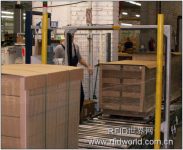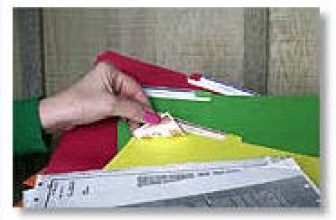
Lithuanian furniture manufacturer uses RFID system to track IKEA furniture
[ad_1]
SC Freda is one of the largest furniture manufacturers in Lithuania, producing wooden furniture, such as various tables and chairs, cupboards and cupboards in the living room and bedroom. In the past three years, the company has only supplied IKEA retail stores around the world. SC Freda transports an average of 10,000 furniture pallets every month; a total of 15-20 transport trucks are dispatched every day to load 800 pieces of furniture.
In August 2010, SC Freda began using RFID to track furniture sent to IKEA, with the goal of reducing shipping errors and labor costs. In addition, the company also hopes to improve production efficiency.
This RFID system is provided by Lithuanian integrator Autepra to help company management track the time of product production and shipment, so as to understand when and which types of furniture need to be produced. It is very important to achieve this. SC Freda production manager Virginijus Brundza said that due to the relatively small warehouse area, on the one hand, the company must ensure that there is a sufficient amount of products on hand to complete user orders, and on the other hand, the production of products must not be excessive to avoid occupying warehouse space. . This system includes PC Gen 2 passive RFID tags (attached to the flexible film of each product packaging), a reader located at the product labeling point, an RFID portal reader on the loading platform, and a forklift with on-board computer- When forklift operators load the truck, they can check the order update status based on the RFID read information. SC Freda’s existing Pragma (ERP) system supplier Proringas provides RFID data management software (integrated into the company’s back-end system).

When a piece of furniture is produced, the worker sticks an EPC Gen 2 label on the outer layer of the packaging film and sends them through an RFID door reader
SC Freda manufactures and stores furniture in its factory in Kaunas, and some of the furniture is sent to a distribution center in SC Freda. At the production site, when the products are loaded on pallets, wrapped in plastic stretch film, they are shipped to a warehouse in the same building, waiting for a third-party transportation company to send them to IKEA stores or SC Freda’s out-of-town distribution center. Before adopting the RFID system, employees pasted a green sticker on the packaging film of each piece of furniture entering the warehouse. When the furniture is loaded on a truck and ready to be shipped to IKEA, workers remove it and count the stickers. This sticker method helps the production department to monitor the furniture produced and stored every day, and to determine whether additional furniture needs to be produced. However, this manual inventory process is very time consuming and prone to errors.
In addition, this method may also produce transportation errors, such as incorrect quantities of products being sent to a specific location. When the error occurred, Brundza stated that SC Freda had to reorganize product shipments. With this new system, Brundza hopes to reduce the labor time spent on daily product inventory, track which products are loaded on which truck, and also reduce the chance of error.

A UPM Raflatac EPC Gen 2 RFID tag is attached to each piece of furniture
Using the RFID system, Autepra director Tomas Girdzevicius said that a piece of furniture was placed on a pallet after production, wrapped in a plastic film, and an adhesive UPM Raflatac EPC Gen 2 label was affixed to the outer layer of the film. Then, the product is moved to a conveyor belt, flows through an RFID warehouse door (including CAEN RFID reader), the reader writes the type of furniture and the time and date on the tag. The furniture is then moved off the conveyor belt and transported 15 feet using a forklift to the warehouse. Because every piece of furniture that is removed from the conveyor belt is immediately sent to the warehouse, there is no need to read the label when they enter the warehouse.
When the warehouse receives the order from the store, the forklift operator checks the order on the on-board computer screen. The 10-inch screen displays a series of products required for the order. The operator then picks up the order according to the order and delivers the product to a waiting transport truck. When the forklift passes the RFID door of the loading dock, the CAEN A948 reader reads the unique ID code and furniture description of the tag, which is compared with the order information displayed by the Freda ERP system.

The RFID portal reader on the loading platform reads the forklift and cargo tags and sends confirmation messages
The Pragma software then sends the updated information of the freight status to the forklift computer screen. The screen displays the loaded products in green or sends an alert if it detects that the incorrect goods are loaded onto the truck. In this way, Brundza said, because the error was discovered before the truck was loaded, it could be easily dealt with. When a truck is loaded, the forklift computer sends a confirmation message to the operator. When the vehicle arrived at the destination and unloaded, IKEA employees no longer read the RFID tags of the furniture. Instead, Brundza explained, they scanned the barcode labels that SC Freda affixed to each item.
Pragma software can also detect whether the RFID tag has been read correctly. The forklift itself is equipped with EPC Gen 2 RFID tags, and the RFID warehouse door identifies each forklift passing by. The system sets that every time the forklift passes through the RFID door, it must load a piece of furniture with an RFID tag when it heads to the truck. If the reader does not read the tag, the system will send an alert to the forklift driver. If the driver does not carry a pallet, he can invalidate the alarm. If there is a delivery pallet, he realizes that the label has not been read correctly and informs the relevant personnel to solve the problem.
If an employee needs to locate a specific piece of furniture in the warehouse, he can use a Nordic ID PL3000 handheld with an embedded RFID reader to search based on the ID code of the tag.

Employees can use a Nordic ID PL3000 handheld to identify specific goods
After installing this system, the SC Freda production department uses it to check the goods being shipped and arrange the production plan accordingly. If the quantity of a certain type of furniture reaches the acceptable minimum inventory, the software will also send an alert to the production department.
The biggest challenge in the application of this RFID system, Brundza said, is how to ensure that only tags passing through the RFID door of the loading station are read. Due to the relatively small size of the warehouse-only 800 square meters-some pallets passing a few feet away from the RFID door will also be read. In order to solve this problem, Girdzevicius said, Sutepra installed RF shields to reduce the length of tag signal transmission into the warehouse.
In the future, Brundza also hopes that the company will label raw materials and track their storage and production processes.
[ad_2]




